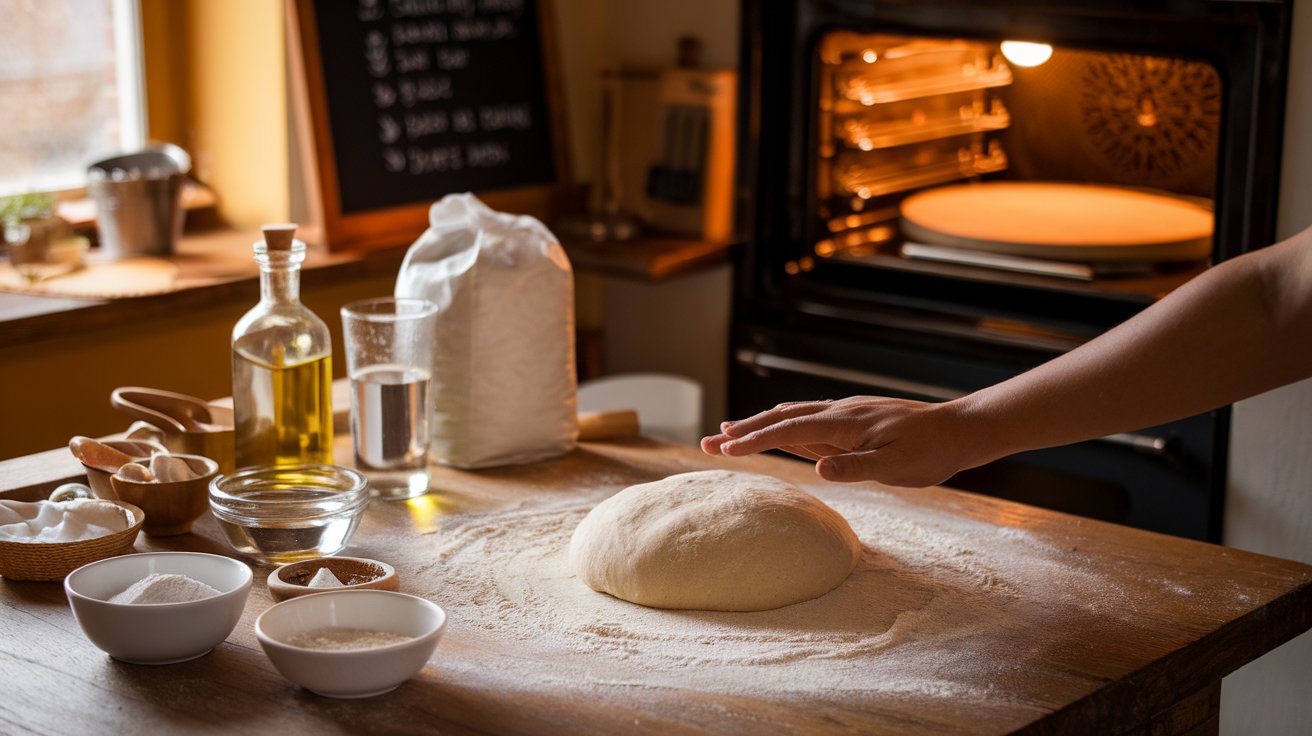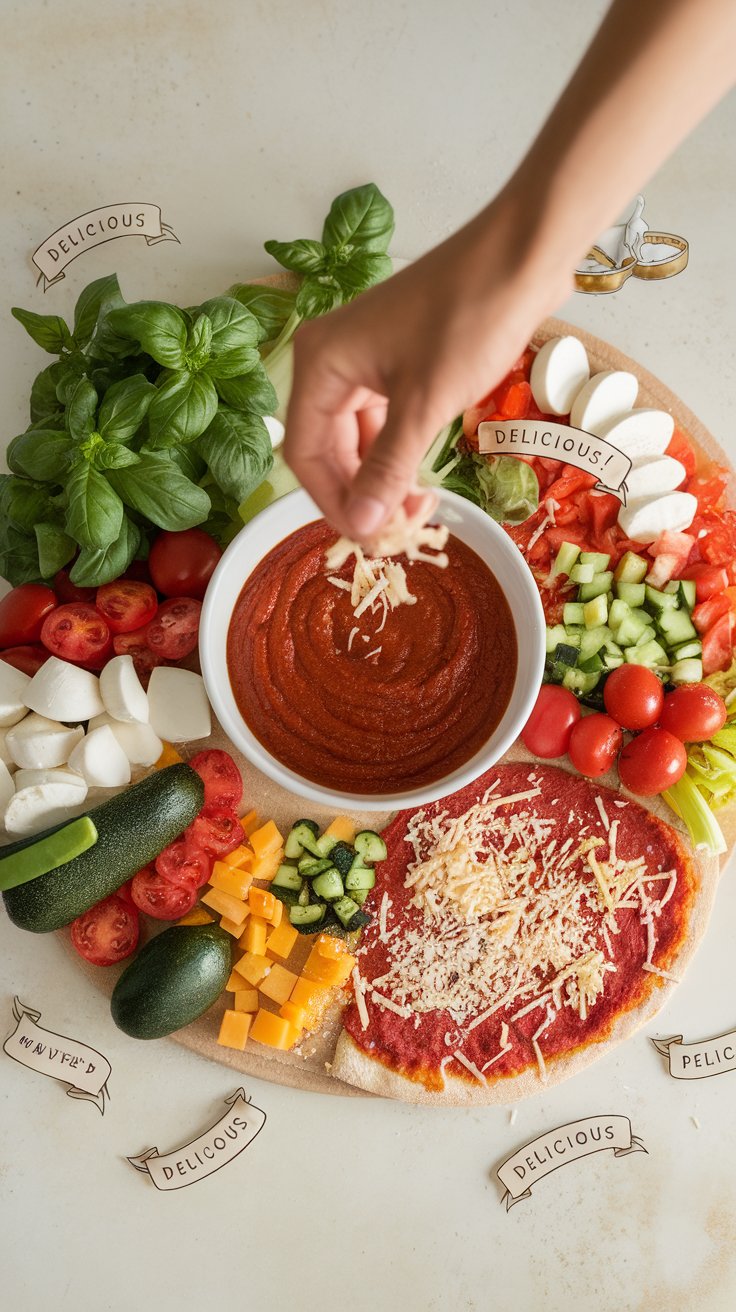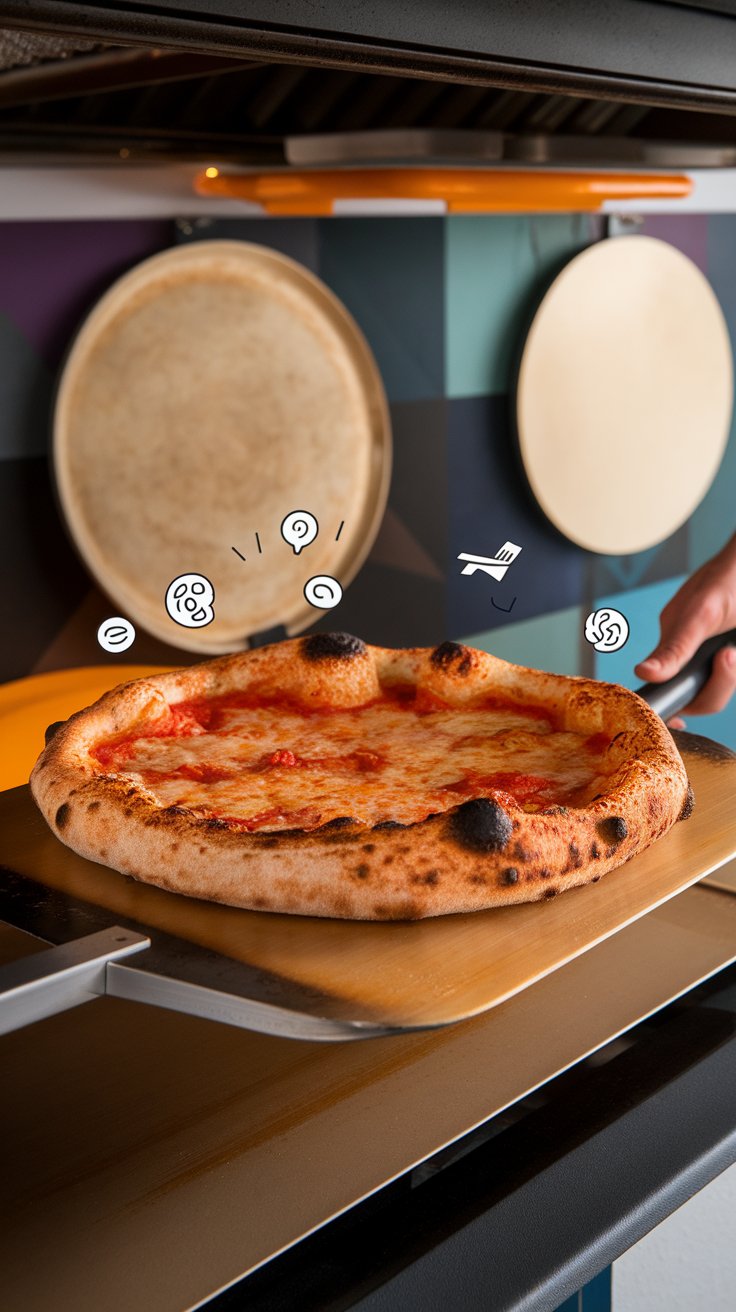Introduction
In this guide, we explore how to make the best homemade pizza by mastering every step—from preparing a reliable pizza dough recipe and activating yeast to creating a vibrant homemade pizza sauce. Whether you’re using a pizza stone, pizza pan, or baking sheet, you’ll discover techniques that ensure a perfectly risen dough, a crispy crust, and delightful toppings like fresh basil and mozzarella. This journey is designed to make pizza making both fun and accessible for every home chef.
Our easy pizza guide empowers you to confidently stretch the dough and build a family pizza bursting with flavor. Learn to balance simple ingredients like olive oil and active dry yeast while perfecting recipes for a classic margherita pizza or a creative veggie pizza. With tips on using a pizza peel and managing a hot oven, protecting the pizza maker becomes an integral part of every successful pizza night.
Key Takeaways
- Mastering homemade pizza starts with a reliable dough recipe that ensures proper yeast activation and an optimal dough rise.
- A well-crafted homemade pizza sauce, combined with carefully selected toppings, elevates the overall flavor profile.
- The use of quality equipment—such as pizza stones, pans, and peels—is essential for achieving a consistently crispy, golden crust.
- Clear, step-by-step techniques are crucial for successfully stretching and baking the dough without compromising safety.
- Practical tips and troubleshooting methods enhance the pizza-making process while protecting the pizza maker from potential hazards.
- Embracing these methods creates a memorable pizza night experience, balancing culinary creativity with safety and efficiency.
Mastering Homemade Pizza Dough: Yeast Activation, Dough Rise, and Making the Dough
Creating a standout homemade pizza starts with perfecting your dough. Begin by following a trusted pizza dough recipe that instructs you to mix active dry yeast with warm water and olive oil, forming a ball of dough that is ready to rise. Allow the dough to rest in a warm spot so that it reaches the ideal dough rise, ensuring it becomes soft yet sturdy. Whether you choose to divide the dough in half for two pizzas or make a family pizza, the process of letting the dough rise is critical. This method results in a light, airy base perfect for topping with homemade pizza sauce, fresh mozzarella, and your favorite pizza toppings. Every step ensures your homemade pizza dough is easy to work with and ready for baking.
How to Activate Yeast for the Best Homemade Pizza Dough
When making homemade pizza dough, the first critical step is to activate your active dry yeast properly. Begin by mixing warm water with a small amount of sugar and olive oil, then stir in the yeast until it froths, forming a promising ball of dough. This process is essential in a reliable pizza dough recipe and sets the stage for the dough rise that makes your crust light and airy. Allow the mixture to sit, ensuring the yeast is fully activated before you press the dough into the bowl. Following these detailed steps helps you make homemade pizza with consistency, whether you plan to divide the dough in half for two pizzas or prepare a family pizza. This method is a go-to pizza making technique for ensuring perfect results.
Techniques for Achieving the Perfect Dough Rise in Your Homemade Pizza Dough Recipe
Achieving an ideal dough rise is crucial for a homemade pizza recipe that yields a soft yet crisp crust. Begin by kneading your dough with olive oil and a dough hook until smooth and elastic. Then, place the dough in a warm spot and cover it to allow the dough to rise naturally. As the yeast activates, the ball of dough expands, creating air pockets that contribute to a lighter pizza crust. Whether you stretch the dough onto a pizza pan or a baking sheet, ensuring even rise throughout is key to a balanced homemade pizza dough. This process, when executed correctly, makes the difference between a dense base and a delicious, airy pizza that stands up to rich toppings like fresh mozzarella and homemade pizza sauce.
Key Insights for Dough Perfection
1. Precise Ingredient Preparation
Measure water, flour, olive oil, and yeast accurately to ensure the perfect chemical balance for activating yeast. This precision sets the stage for successful fermentation and robust dough development.
2. Mastering Yeast Activation
Utilize warm water combined with a hint of sugar to awaken the yeast effectively. This step is critical to achieve the proper rise, resulting in a light, airy dough that forms the foundation of a delicious pizza.
3. Controlled Dough Resting and Rising
Allow the dough to rest in a warm, draft-free environment. A controlled rise not only enhances the texture but also improves the flavor profile, ensuring each pizza base is evenly fermented and ready for toppings.
4. Expert Kneading Techniques
Adopt thorough yet gentle kneading methods to develop gluten structure without overworking the dough. This practice contributes to a smooth, elastic consistency that makes stretching and shaping easier for a perfect crust.
Building Your Favorite Pizza: From Homemade Pizza Sauce to Tasty Toppings
Your favorite pizza begins with a vibrant homemade pizza sauce and an assortment of fresh toppings that reflect your personal taste. Start by preparing a rich tomato sauce, seasoned to perfection, to spread evenly over your homemade pizza dough. Layer on classic toppings like fresh basil, sliced tomatoes, and creamy fresh mozzarella, or get creative with a veggie pizza mix that adds crunch and flavor. Using ingredients like olive oil and active dry yeast in the dough, you ensure that every bite is balanced between a crispy pizza crust and savory toppings. The process of layering sauce, cheese, and toppings transforms your homemade pizza recipe into a memorable meal that delights every pizza lover.
Crafting a Rich Homemade Pizza Sauce: Tips and Tricks for a Flavorful Base
Creating a vibrant homemade pizza sauce is the heart of a memorable pizza night. Start with a classic tomato sauce, seasoned with herbs like fresh basil and a hint of olive oil, to form a flavorful base. Incorporate a trusted pizza sauce recipe that balances acidity with sweetness, ensuring that the sauce spreads evenly over your homemade pizza dough. As you stir the sauce, add subtle spices that complement the tang of tomato and the creaminess of fresh mozzarella. This process transforms an ordinary pizza into a culinary delight. Whether preparing a margherita pizza or a veggie pizza, a well-crafted sauce enhances every bite, making it easy to make pizza that not only tastes delicious but also stands out among other pizza recipes.
Layering Toppings on Your Pizza: From Fresh Basil to Veggie Pizza Delights
Layering toppings with care is essential for building your favorite pizza. Begin by evenly spreading your homemade pizza sauce over the dough, then add slices of fresh mozzarella and vibrant vegetables like bell peppers, onions, and tomatoes. Top your creation with fresh basil leaves or even a drizzle of olive oil to enhance the flavor profile. For those who love pizza, experimenting with a pesto pizza twist or adding a sprinkle of active dry yeast can introduce unique textures and tastes. Whether you opt for a classic margherita pizza or a creative veggie pizza, the technique of layering ensures that each topping is perfectly placed and balanced. This approach transforms an easy pizza recipe into a personalized culinary masterpiece that caters to every taste.
Case Study: Transforming Homemade Pizza Sauce at Bella Cucina
At Bella Cucina, a celebrated neighborhood pizzeria in New York, Chef Marco set out to perfect his homemade pizza sauce, a critical component in building the favorite pizza that customers love. Faced with the challenge of creating a sauce that stood out from conventional store-bought varieties, Marco embarked on an experimental journey rooted in traditional Italian techniques. He sourced vine-ripened tomatoes, fresh basil, and high-quality olive oil, then meticulously adjusted the balance of ingredients over several trial runs.
By slow-cooking the tomatoes to release their natural sweetness and adding basil at the very end to preserve its aromatic freshness, Marco crafted a sauce that consistently enhanced the overall flavor profile of his pizzas. His methodical approach resulted in a noticeable boost in repeat patronage and rave reviews from local critics, inspiring home chefs to experiment with their own versions of homemade pizza sauce.
Achieving the Perfect Crust: Using Pizza Stone, Pizza Pan, and Baking Sheet Techniques
Getting a perfect crust is a game-changer for any homemade pizza. Whether you use a pizza stone, a pizza pan, or a baking sheet, each tool plays a vital role in baking the pizza evenly. Preheat your oven to the right temperature and place the dough carefully onto the chosen surface to ensure a consistent heat distribution. The use of a pizza peel helps you slide the pizza onto the stone or pan, reducing the risk of disturbing the dough’s structure. This method not only results in a crispy, golden-brown crust but also enhances the flavor of the pizza. As the dough bakes, the edges turn delightfully crisp, offering that perfect texture contrast for an exceptional pizza experience.
Mastering Pizza Stone Usage: How to Use a Pizza Peel and Preheat the Oven
To achieve the best homemade pizza crust, mastering the pizza stone is key. Begin by preheating your oven with a pizza stone inside, ensuring it reaches the perfect temperature to bake your dough evenly. Use a pizza peel to carefully slide the stretched dough onto the stone without disturbing its shape. This technique helps create a crispier crust and a golden-brown finish around the edges. Incorporate tips from a reliable pizza dough recipe to maintain consistency whether you’re using a pizza stone or a pizza pan. By following these precise steps, you make pizza that not only looks professional but also tastes exceptional.
Baking Techniques for a Crisp Pizza Crust: Comparing Pizza Pan, Stone, and Baking Sheet
Selecting the right surface for baking is essential to achieve a perfectly crispy pizza crust. Whether you use a pizza pan, a pizza stone, or a baking sheet, each option has unique benefits for your homemade pizza. A pizza stone offers an evenly distributed heat that results in a golden, well-cooked crust, while a pizza pan or baking sheet may provide a softer edge. Experiment with these surfaces to see how each one affects the texture and flavor of your dough. Ensure you preheat the oven thoroughly and use a pizza peel to slide the pizza safely. By comparing these techniques, you can perfect the art of making pizza, from using an easy pizza dough recipe to ensuring the crust is consistently crisp, inviting, and delicious with every bite.
“A perfect pizza crust is the result of precision, the right heat, and genuine passion in every step.” — Gino D’Acampo, Celebrity Chef
Practical Tips for a Safe Pizza Night: Easy Pizza Recipes and Protecting the Pizza Maker
Hosting a pizza night is all about enjoying the process while keeping safety and equipment protection in mind. Using an easy pizza dough recipe ensures that even beginners can make a delicious homemade pizza without compromising on quality. Carefully follow each step—from yeast activation to stretching the dough—while paying attention to using proper tools like pizza pans, stones, and peels. Emphasize safe handling practices, especially when the pizza is hot and fresh out of the oven. This approach not only results in a perfectly baked pizza with a crisp crust but also protects the pizza maker from potential mishaps. Incorporating these practical tips into your routine guarantees a fun, safe, and stress-free experience for every pizza night.
Essential Safety Tips for a Fun and Secure Pizza Night at Home
A successful pizza night is as much about safety as it is about taste. Start by setting up your kitchen with proper tools like a pizza pan, pizza stone, and pizza peel to ensure you can make pizza without risks. Follow an easy pizza dough recipe that emphasizes safe handling techniques, such as carefully placing the dough and using oven mitts when the pizza is hot. Keep a clean workspace and be mindful of sharp utensils when preparing toppings and stretching the dough. This careful approach not only protects the pizza maker but also ensures the final product, whether it’s a margherita pizza or a family pizza, is cooked to perfection. By integrating these safety practices, every pizza night remains fun, secure, and free of mishaps.
Step-by-Step Guide to Using Easy Pizza Recipes that Protect the Pizza Maker
When you love to make homemade pizza, following a structured, easy recipe can safeguard your pizza-making process. Start with clear, step-by-step instructions that guide you through activating yeast, preparing homemade pizza dough, and stretching the dough onto a pizza pan or stone. Emphasize critical moments, like preheating the oven and sliding the pizza carefully with a pizza peel to avoid burns. This guide incorporates essential safety tips while ensuring that each ingredient—from tomato sauce to fresh basil—is added thoughtfully. Whether you’re making a classic margherita or experimenting with a veggie pizza, the process protects the pizza maker from common kitchen hazards. Enjoy your pizza night with confidence, knowing that every step is designed to deliver a perfectly cooked, safe, and delicious homemade pizza.
Conclusion
Concluding our journey through the art of making homemade pizza, we’ve covered essential techniques—from activating yeast and achieving a perfect dough rise to layering vibrant toppings and mastering the use of pizza stones and pans. Each step reinforces the importance of safety and precision in your kitchen, ensuring that every pizza you bake not only delights with its flavor but also upholds the craft and protection of the pizza maker.
In wrapping up, remember that every element, whether it’s a well-risen dough or a carefully spread tomato sauce, contributes to a memorable pizza night. Embrace these practical tips and creative techniques to consistently deliver a delicious, safe, and inviting pizza experience. Enjoy experimenting with new toppings and variations as you perfect your own signature pizza recipe.


















